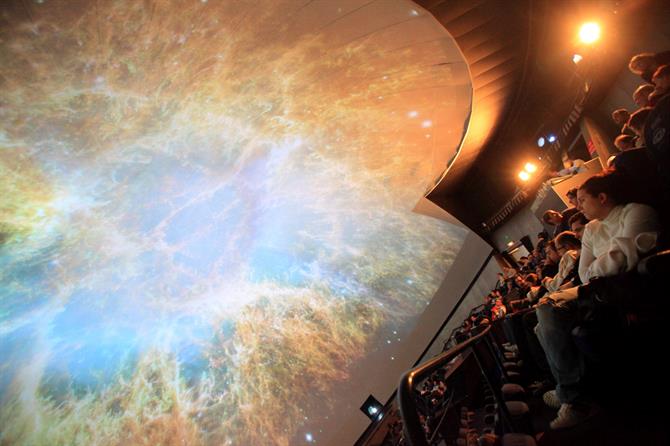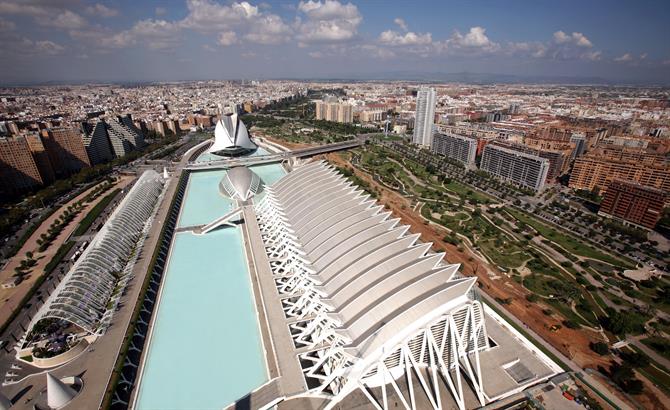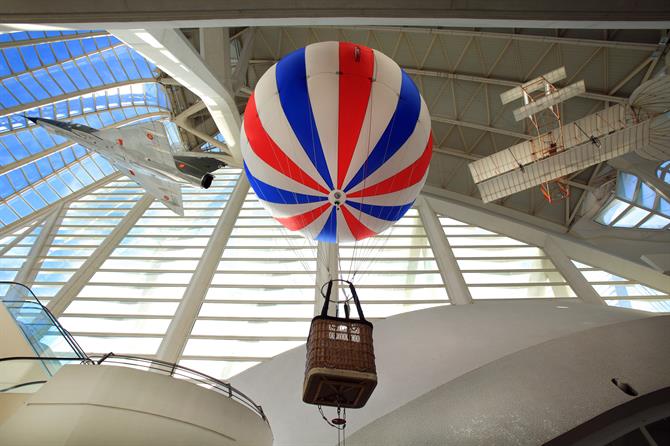Those who know the district of La Défense in Paris have likely already experienced the feeling of being on another planet. This is similar to what you will experience when you visit the City of Arts and Sciences in Valencia.
At the end of the 20th century, construction commenced and the first installation of the project was finally opened in April 1998.
This first installation is known as...
L'Hemisfèric

L'Hemisfèric is an impressive building that was designed by the architect and engineer Santiago Calatrava. The building exudes symbolism; it's shaped like a human eye, representing the eye of wisdom. A beautiful, large lake (24,000 m²!) surrounds l'Hemisfèric, adding to the awe and beauty of this modern "city".
This architectural jewel of modern style is a theatre and planetarium, in which three systems are used: the large IMAX Dome, 3D digital cinema, and digital projections. Films and documentaries of various themes are offered to the public, particularly addressing such topics as astronomy, nature, science, and cultures from different times and places.
Films for children are also scheduled for the delight of the little ones.
Interior L'Hemisfèric

Its large concave screen spanning 900 m², along with its "space transmitters" that that are placed on the viewers' heads, make the experience and the atmosphere seem almost magical.
The images cover the entire screen with the use of 6 projectors, integrating the viewer in a way that makes them feel a part of the show. It is the largest room in Spain of its kind.
This modern colossal architect takes up no less than 350,000 m², stretching along almost 2 kms!
The project continued along the Turia River, whose bed has been dry since the great flood of 1957, as the water was diverted to prevent future floods in the city. Today, the Turia River is frequented by athletes and sports enthusiasts, walkers and cyclers, and serves as a venue for fairs and festivals, among other things. Oh, and its located along one of the most important and influential buildings in the world: The City of Arts and Sciences.
By the turn of the century, it became - and continues to be - a global icon of the Spanish city of Valencia. The Prince Felipe Museum of Science, which took its name in honor of the current Spanish king, was erected as the next addition to the "city".
Prince Felipe Museum of Science

This incredible building, the Prince Felipe Museum of Science, hosts a journey from the origin of life to the present day through the prism of technological and scientific developments that have occurred throughout the history of humanity and that seek to determine the progress of the future.
This science museum is also a work of architect Santiago Calatrava. Its 26,000 m² of space makes it the biggest science museum in Spain.
The more than 4,000 crystals surrounding the museum create a bright environment, particularly in a city where the Mediterranean sun fills everything with light, giving energy to the visitors to move around the immense 42,000 square meters of surface.
Going inside this incredible museum

This is a highly interactive museum, as evidenced by the slogan that encourages everyone to participate in the many activities: "Prohibido no tocar, no sentir, no pensar" or, "Forbidden not to touch, not to feel, not to think."
Prince Felipe Museum of Science is a gateway to knowledge, where science welcomes and encourages people of all ages and interests, with children in particular as they present knowledge in a fun and enjoyable way! It's been proven that being taught through emotion is more easily learnt and remains firmly rooted in our memory.
In the museum, there are exhibits that are permanent as well as some that are temporary, highlighting history's greatest discoveries and exhibitions of different topics, such as one that the company Pixar did celebrating "25 Years of Animation" (which was a huge success with visitors)!
Among the permanent exhibitions are "Chromosome Forest", "Zero Gravity", "Electricity Theatre" and "Communicating, from smoke signals to satellites".
Electricity Workshop
In the Electricity Workshop, visitors can easily understand and enjoy all there is to know about producing electricity.
Zero Gravity
Zero gravity, another cool project in the museum, has the support of the European Space Agency! An array of telescopes and space satellites make up the exhibition, with the highlight being a space-like room that makes you feel like an astronaut peering down on Earth just as if you were in the International Space Station. Simply amazing!
How to get there:
The easiest way to get to the City of Arts and Sciences is by public transport.
You can take buses 19, 35, 95 and 40. Some of them leave from the Plaza del Ayuntamiento. Another option is to go by Metro. Lines 3 or 5, will drop you off at Alameda and you can stroll along the beautiful Turia riverbed, a pleasant walk of about 15 minutes. Of course, there are also bike routes that can get you there!
Stick around for part two of this article, outlining more of the incredible buildings that make up the City of Arts of Sciences.
While in the city, be sure to check out:
La Tomatina (the well-known tomato festival held every August!)
